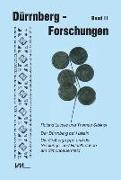- Start
- Der Dürrnberg bei Hallein
Der Dürrnberg bei Hallein
Angebote / Angebote:
Den in DF5-10 publizierten Gräberfeldern folgen als siebtes und letztes die 1984 und 1987 untersuchten Befunde des nordwestlich der Kirche gelegenen Simonbauernfeldes, an dessen Ausgrabung Th. Stöllner selbst teilgenommen hatte. Die mit nur 13 Grabanlagen sehr kleine, aber reiche und durch Ritualhandlungen im Umfeld der Gräber sehr komplexe Nekropole enthält mehrere Gräber der Frühzeit der Besiedlung und eine besondere Häufung sogenannter Hallstattdolche, die zusammen mit anderen Fremdformen die Westkontakte und Südkontakte des Dürrnbergs unterstreichen. Auch zu den Themenfeldern der Bestattungssitten mit umfassenden Grabmanipulationen und einem mutmaßlichen Ahnenkult, der engen Verzahnung von Grabstrukturen und Siedlungsstrukturen sowie vereinzelter Gräber der Mittellatènezeit liefert die Nekropole wichtige Informationen. Befunde wie eine Plattform mit Terrassierungsmauern und Resten kommensaler Handlungen oder markante Steinsetzungen [Kreis, Kegel] zeugen von einem Erinnerungsort des 6.-1. Jh. v.Chr. Zur Interpretation der ca. 400 Gräber des Dürrnbergs mit weitaus mehr Individuen folgt die abschließende Gesamtpublikation.
After the cemeteries published in DF 5-10 the seventh and last individual volume presents the evidence from Simonbauernfeld north-west of the church, which was excavated in 1984 and 1987 with Th. Stöllner being a member of staff. This very small, but rich cemetery of thirteen graves stands out for its complex nature with ritual activity in the spaces between graves, several graves of the initial stages of occupation, and a particular plenty of so-called Hallstatt daggers supporting - together with other imported goods - the westerly and southerly contacts of the Dürrnberg people. It also yielded important information on the topics of burial rites, including considerable manipulation of graves and a potential cult of ancestors, the narrow interlocking of grave and settlement structures, as well as individual graves of the Middle La Tène period. Features such as a platform with terrace walls and remains of commensal events or prominent stone settings [circle, cone] attest a memorial site of the 6th to 1st century B.C. For the overall interpretation of the some 400 graves of the Dürrnberg with far more individuals the concluding final publication is to follow.
Libri-Titel folgt in ca. 2 Arbeitstagen
